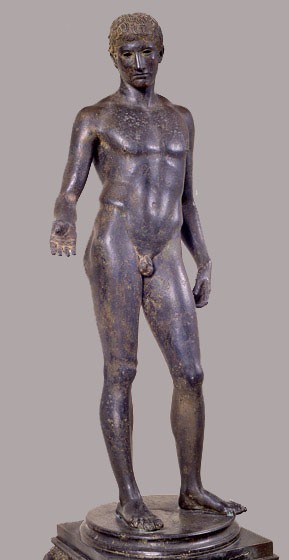Made during the Augustan era, the sculpture pictured represents an adolescent youth on the brink of manhood. The statue was nicknamed the "Idolino" (little idol) only in the nineteenth century. Its idealized style emulates Classical sculpture by the fifth-century Greek sculptor Polykleitos, but treats the figure's body in a more generalized manner. When the Idolino was unearthed in Pesaro, Italy, in 1530, the figure held bronze grape leaves in one hand, leading to its misidentification as Dionysos, god of wine — indeed, the elaborate Renaissance pedestal depicts the god's consort Ariadne, prancing satyrs, and a ritual sacrifice. In fact, the statue was an elegant furnishing accessory. As in the case of a statue of Apollo (see Greek Art and Roman Collectors), the grape leaves were mere supports for a tray, probably for an oil lamp to illuminate an evening gathering at the home of a wealthy Roman.
Pictured: Youth ("Idolino"), c. 30 BC; bronze, copper, and lead. Lent by Soprintendenza per i Beni Archeologici della Toscana (Museo Archeologico Nazionale, Firenze)
